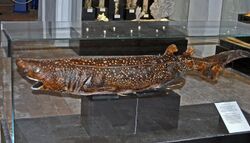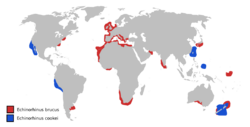Biology:Echinorhinus
| Echinorhinus | |
|---|---|

| |
| Bramble shark, Echinorhinus brucus | |

| |
| Echinorhinus brucus, mounted specimen, on display at the Natural History Museum of the University of Pisa | |
| Scientific classification | |
| Domain: | Eukaryota |
| Kingdom: | Animalia |
| Phylum: | Chordata |
| Class: | Chondrichthyes |
| Subclass: | Elasmobranchii |
| Subdivision: | Selachimorpha |
| Order: | Squaliformes |
| Family: | Echinorhinidae T. N. Gill, 1862 |
| Genus: | Echinorhinus Blainville, 1816 |

| |
| The distribution of the two Echinorhinus species | |
Echinorhinus is the only extant genus in the family Echinorhinidae.
Taxonomy
Echinorhinidae are traditionally classified in the order Squaliformes, together with kitefin and gulper sharks.[2][3] However, a phylogenetic estimate based on gene capture data and mitochondrial data suggests that they are not squaliform sharks, but may be more likely to be appropriately classed in their own group, as a sister group to angel sharks and sawsharks.[4][5] Phylogenetic placement of Echinorhinidae has been ambiguous in morphological and molecular studies, either being included within Squaliformes, considered sister to Squaliformes, or placed in a separate group with Sawsharks (Pristiophoriformes) or angel sharks (Squatiniformes).[4] For this reason they are sometimes given their own order, Echinorhiniformes.
Etymology
The name is from Greek echinos meaning "spiny" and rhinos meaning "nose".
Species
- Echinorhinus brucus Bonnaterre, 1788 (bramble shark)
- Echinorhinus cookei Pietschmann, 1928 (prickly shark)
Description
This genus includes two extant species of uncommon, little-known sharks. Both species are relatively large sharks, at 3.1 to 4.0 m (10.2 to 13.1 ft) in body length. They are characterized by a short nose and by rough, thorn-like dermal denticles scattered over its body, some of which may be fused together. They have no anal fin. Two small spineless dorsal fins are positioned far back.
Biology
They are ovoviviparous, with the mother retaining the egg-cases inside her body until they hatch, producing litters up to 24 pups.[6] They feed on smaller sharks, smaller bony fish, and on crabs and cephalopods.
Distribution
These sharks are found worldwide in cold temperate to tropical seas from the surface down to 900 m (3,000 ft).[6]
See also
- List of prehistoric cartilaginous fish genera
- List of fish families
References
- ↑ Sepkoski, Jack (2002). "A compendium of fossil marine animal genera (Chondrichthyes entry)". Bulletins of American Paleontology 364: 560. http://strata.ummp.lsa.umich.edu/jack/showgenera.php?taxon=575&rank=class. Retrieved 2008-01-09.
- ↑ Compagno, 2005. "Sharks of the World". ISBN:9780691120720
- ↑ "Echinorhinus brucus". Florida Museum. https://www.floridamuseum.ufl.edu/discover-fish/species-profiles/echinorhinus-brucus.
- ↑ 4.0 4.1 Straube, Nicolas; Li, Chenhong; Claes, Julien M.; Corrigan, Shannon; Naylor, Gavin J. P. (2015). "Molecular phylogeny of Squaliformes and first occurrence of bioluminescence in sharks". BMC Evolutionary Biology 15 (1): 162. doi:10.1186/s12862-015-0446-6. ISSN 1471-2148. PMID 26277575.
- ↑ Naylor, G. J. P.; Caira, J. N.; Jensen, K.; Rosana, K. A. M.; Straube, N.; Lakner, C. (2012). Elasmobranch Phylogeny: A Mitochondrial Estimate Based on 595 Species. In: Biology of Sharks and Their Relatives.. Boca Raton, CRC Press, Taylor & Francis Group. p. 31-56. ISBN 978-1-4398-3924-9.
- ↑ 6.0 6.1 Froese, Rainer, and Daniel Pauly, eds. (2009). "Echinorhinidae" in FishBase. January 2009 version.
- "Echinorhinus". Integrated Taxonomic Information System. https://www.itis.gov/servlet/SingleRpt/SingleRpt?search_topic=TSN&search_value=160712.
- Froese, Rainer and Pauly, Daniel, eds. (2006). Species of Echinorhinus in FishBase. January 2006 version.
- FAO Species Catalogue Volume 4 Parts 1 and 2 Sharks of the World
Wikidata ☰ Q1473514 entry
 |

